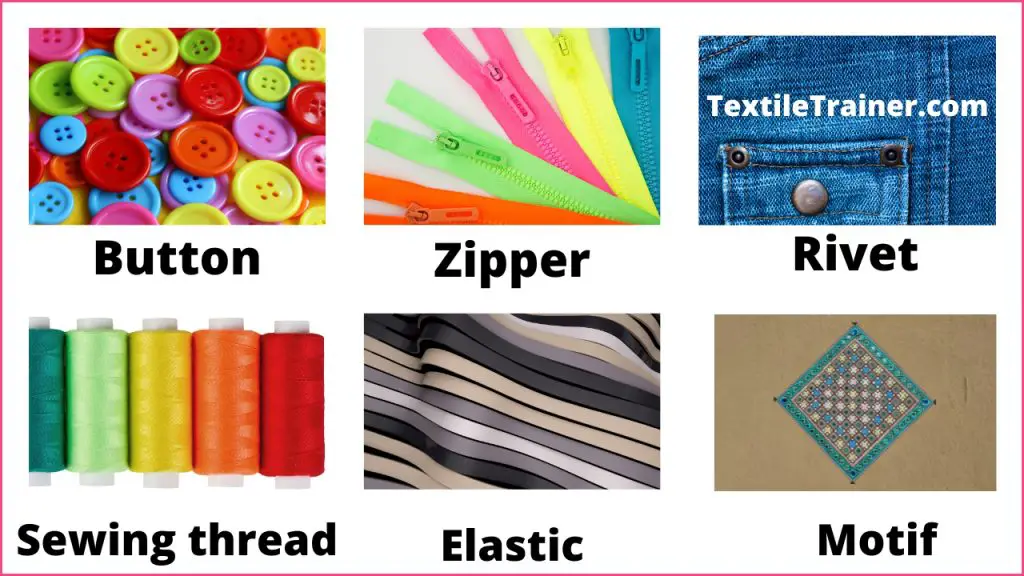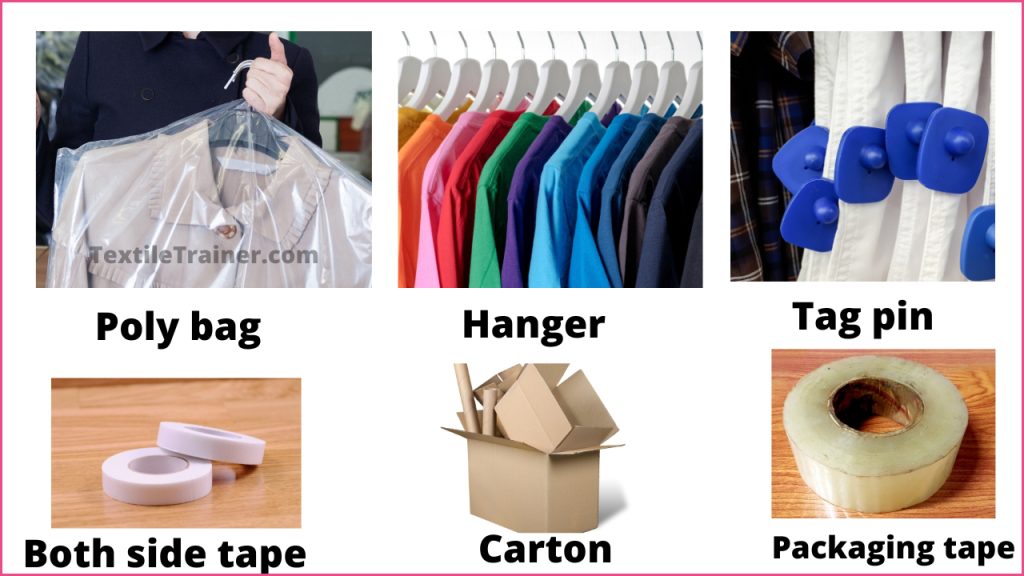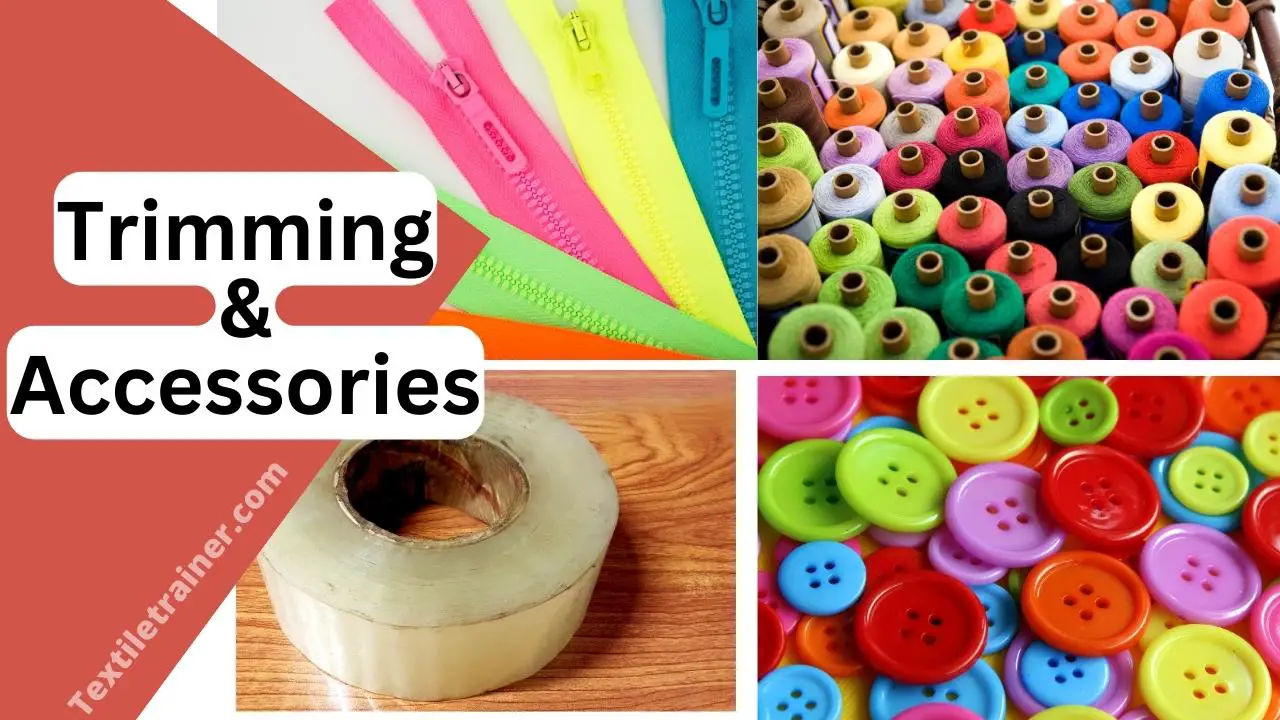Name of the Experiment:
Study on trimmings and accessories used in garments manufacturing.
Introduction:
In the world of fashion and garment manufacturing, trimmings and accessories play a vital role in adding finesse, style, and functionality to the finished product. An ordinary garment can become a statement piece with the help of these seemingly insignificant details, such as buttons, zippers, ribbons, buckles, patches, and appliques. The purpose of our experiment is to shed light on the significance, evolution, and diverse applications of trimmings and accessories in fashion. Our aim is to provide valuable insights into how the latest trends, materials, and manufacturing techniques contribute to the overall aesthetics, durability, and consumer appeal of garments by examining the latest trends, innovative materials, and manufacturing techniques.
Furthermore, we will examine the evolving consumer preferences and demands for unique and personalized fashion, highlighting how trimmings and accessories serve as tools for self-expression and individuality. During this session, we’ll discuss how these elements can strengthen brand identity, improve product differentiation, and improve consumer relations with clothing.
Objectives:
- To get a better understanding of the different types of trimmings and accessories
- Come learn the difference between trimming and accessories
- Identifying and defining brand values through trimmings and accessories.
- Investigate how trimmings and accessories can enhance garment usability and durability.
Trimmings:
Trimming is a wide range of decorative elements that are attached to garments by sewing and are used to embellish them. In other word, The materials that are required to make a garment other than the main fabrics are called trimmings. Trimmings are often regarded as the finishing touch, giving the garment a unique flair, style, and personality. In addition to fabric, metal, plastic, or natural materials, they can also be made from wood or shells. Consumers and designers have endless options for customizing and personalizing their clothing with trimmings. With carefully selected and positioned trimmings, plain garments can become statement pieces that express a wearer’s style and personality. They can be used to create intricate patterns, interesting textures, or eye-catching focal points.

List of Trimmings Used in garments Manufacturing:
| Button | Zipper |
| Rivet | Lining |
| Hook and loop | Stopper |
| Braid | Elastic |
| Label | Velcro tape |
| Ribbon | Wadding |
| Lace | Twill tape |
| Interlining | Shoulder pad |
| Motif | Sewing thread |
The following are some important trimmings that you must need to know about:
- Button: A button is a small, round or shaped fastener used in fashion and textiles that serves both decorative and functional purposes at the same time. They are a type of trim that is used both for decorative and functional purposes. There is a wide variety of materials available for buttons, including plastic, metal, wood, or fabrics. They are usually used to secure closures on clothing, such as clothing, jackets, pants, and dresses. A button can be attached through a buttonhole, a loop, or any other fastening method, ensuring that the garment stays put when it is worn. The use of buttons makes clothes easier to open and close, as they provide convenience and ease of use.
- Zipper: A zipper is a functional and widely-used trimming in the fashion industry that provides a secure and convenient method of closing and opening garments and accessories. By sliding a mechanism, two strips of fabric tape can be joined or separated by interlocking metal or plastic teeth. Zippers are used primarily to fasten garments, such as jackets, pants, dresses, skirts, or bags, allowing for easy wear and removal. When you slide the zipper pull up or down, the teeth interlock or separate, ensuring a secure closure that keeps the garment in place. Zippers are a great alternative to buttons or other closure methods.
- Lining and interlining: A garment’s lining and interlining are essential components to providing structure, support, and comfort during its construction. In addition to improving the appearance, functionality, and durability of a garment, they are often used in conjunction with the outer fabric. A lining is a separate layer of fabric that is attached to the inside of a garment, covering the inner construction and seams. Interlining, also called interfacing, is a layer of fabric that provides additional support, stability, and shape retention in areas where outer fabric meets lining.
- Elastic: In the fashion industry, elastic is used to provide flexibility, comfort, and a secure fit for a variety of garments and accessories. Rubber-based cords are narrow strips or cords that are often encased in fabric for added aesthetics and durability. The primary characteristic of elastic is its ability to stretch and then return to its original shape. This property allows it to expand and contract, accommodating body movements and providing a snug fit. A waistband, a cuff, a shoulder strap, or lingerie are all examples of areas where elastic provides adjustable tension or stretch ability.
- Label: A label, in the context of fashion and textile products, refers to a small piece of fabric or material that is attached to a garment or accessory. Labels serve many purposes, including providing important information and branding elements. In general, labels are sewn or attached to visible or concealed areas of the garment. They can be made of woven or printed fabric, synthetic materials, or leather, based on the desired feel and look.
- Motif: A motif, in the context of fashion and textiles, refers to a recurring design element, pattern, or symbol that is used to decorate or embellish garments, accessories, or fabric surfaces. By repeating patterns or symbols throughout a collection or within a single garment, motifs create a visual theme and add visual interest to it. A variety of techniques and materials can be used to create motifs, including digital or hand-drawn designs, screen printing, embroidery machines, laser cutting, or hand-sewing embellishments. Colors, textures, and scale can significantly impact a motif’s visual impact.
- Sewing thread: An essential part of garment construction, sewing thread is a thin strand of material that is used to stitch fabric pieces together. Sewing threads are designed to possess specific characteristics that make them suitable for various sewing applications and play a crucial role in creating durable and secure seams. A sewing thread’s choice is influenced by a variety of factors, such as fabric type, intended use, and seam appearance. Choosing a thread that complements the fabric’s characteristics and sewing requirements is important.
Accessories:
Accessories, in the context of fashion and personal style, refers to a piece, or embellishment, that is worn or carried in order to enhance or complete an outfit. It is their purpose to complement clothing and bring an extra touch of style, personality, and functionality to it. The types of accessories that can be worn by a person can range from simple, subtle items to bold, statement-making pieces made of various types of materials, such as metal, fabric, leather, or synthetic materials. Basically, the accessories are materials that are not attached to the body of clothing through sewing, but are only used to finish and pack the clothing (for decorative purposes) in addition to being attached to the body of the garments.

List of Accessories used in Garments Manufacturing:
| Collar stand | Carton sticker |
| Hanger | Backboard |
| Collar stays | Patch |
| Price ticket | Safety pin |
| Brass pin | PP belt |
| Size strip | Hand tag |
| Both side tape | Plastic clip |
| Photo inlay | Pocket flasher |
| Tissue paper | Buckle |
| Tag pin | Polybag |
| Gum tape/Packaging tape | Butterfly |
| Neck board | Drawcord/string |
| Safety sticker | Carton |
Some important accessories are described below:
- Polybag: In the context of garments, polybags are plastic bags made from polyethylene or similar materials. They are mostly used as packaging materials to protect garments during transport and storage. Rather than being a decorative or fashion accessory, polybags are primarily used for packaging and protection. However, in some cases, polybags can contribute to the overall presentation and perception of garments through branding or organization.
- Hanger: Hangers are devices used to store, organize, and display clothing items in a neat, wrinkle-free manner by suspending and supporting them. It is crucial to have hangers as a part of your wardrobe in order to maintain your garment’s shape and condition. Providing support, organization, and display capabilities, hangers are essential garment accessories. By preserving shape and condition, they enable easy access, efficient storage, and aesthetic presentation of clothing items. The longevity and sustainability of clothing can be enhanced by choosing hangers that meet the garment type and align with environmental considerations.
- Collar stand: A collar stand is also known as a collar band or collar back, and it is a component of the collar construction of a garment. This is the part of the collar that wraps around the back of the neck, supporting and stabilizing the collar as well as giving the garment structure and a sense of stability.
- Safety pin: Safety pins are versatile fastening tools that can be used to secure fabric layers, close temporary closures, and connect objects. Designed to create a fastening mechanism both secure and easy to undo, it consists of a metal pin with a coiled spring and clasp at the end.
- Carton: A carton, in general terms, refers to a container or box made from paperboard or cardboard material. Depending on the specific needs and requirements of the contents they hold, cartons come in a variety of sizes, shapes, and configurations that can be used for packaging, storing, transporting, and displaying a wide range of products.
- Packaging tape: A packaging tape is a type of adhesive tape that is used to seal and securing packages or cartons for transportation, storage, or general packaging purposes. It is also commonly known as shipping tape or box sealing tape. It is a versatile tool that provides a strong and reliable closure to keep the contents of the package safe and secure.
- Tag pin: Tag pins are also known as tag fasteners or tag attaching pins, and they can be used to secure tags, labels, or small objects to garments, textiles, or other products. Tag pins come in a range of materials including plastic or metal, usually with a sharp end and a plastic paddle or disc at the other end.
Conclusion:
A knowledge gained from this study can be applied to the garment manufacturing industry to improve the selection, placement, and use of trimmings and accessories. This study can be applied to a variety of situations. It is possible to enhance the overall quality, value, and appeal of garments by carefully considering the specific requirements of each component. Thank you to our teacher for his cooperation in helping us to conduct this experiment.






